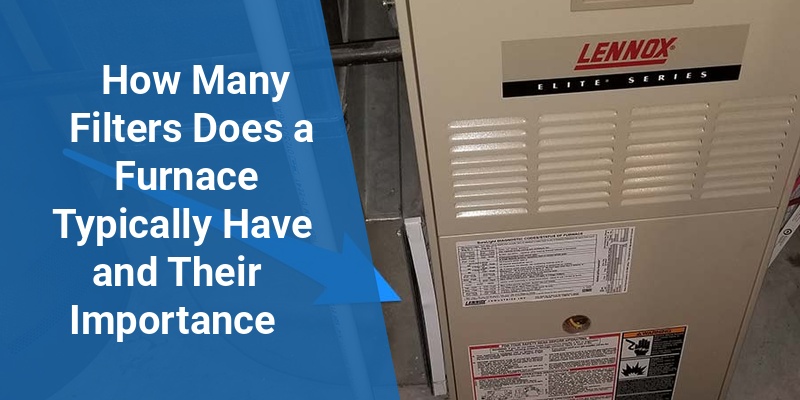Furnaces are a critical component of home heating systems, ensuring comfort and air quality during colder months. One of the essential aspects of maintaining a furnace is its air filtration system. Many homeowners wonder how many filters a furnace has and why each is necessary. Understanding this helps in proper maintenance and preserves the efficiency of your heating system.
| Filter Type | Typical Quantity in a Furnace System | Purpose |
|---|---|---|
| Primary Air Filter | 1 | Captures dust, debris, and airborne particles to protect furnace components |
| Secondary or Pleated Filter (optional) | 0-1 | Provides enhanced filtration for improved indoor air quality |
| Electronic or Electrostatic Filters (in some models) | 0-1 | Removes microscopic particles through electronic charge |
Primary Furnace Filter: The Essential Component
Most residential furnaces have one primary air filter that plays a vital role in protecting the system. This filter is usually located in the return air duct or blower compartment, filtering the air before it reaches the furnace. Its main function is to trap dust, dirt, pet dander, and other airborne particles, keeping the furnace’s heat exchanger, blower motor, and other components clean and functional.
Regularly changing or cleaning this filter is crucial because a clogged filter can reduce airflow, making the furnace work harder and increasing energy costs.
Secondary Filters: Enhancing Indoor Air Quality
Some furnace setups include a secondary or pleated filter in addition to the primary filter. These are often used in systems designed to provide improved air quality. Pleated filters have a greater surface area and finer filtration capability, capturing smaller particles such as pollen and mold spores.
Secondary filters are not present in all installations but are recommended for homes with allergy sufferers or pets. They can be positioned either in the air return or in an air handler unit.
Electronic and Electrostatic Filters in Modern Furnaces
Advanced furnace systems may incorporate electronic or electrostatic filters, which can function without the need for regular replacement. They use an electronic charge to attract and trap microscopic particles such as smoke, bacteria, and viruses, significantly enhancing indoor air purity.
These filters are typically a single unit integrated into newer, high-efficiency furnaces. While they can be more expensive upfront, they reduce the frequency of filter changes and improve air quality effectively.
Call 888-906-9139 for Free Local HVAC Quotes – No Obligation, Just Savings!
Factors Influencing the Number of Furnace Filters
- Furnace Model and Design: Simpler models usually have one filter, while sophisticated HVAC systems may have multiple filtering stages.
- Home Air Quality Needs: Homes with high pollution, pets, or allergy concerns might benefit from additional filters.
- Filter Type Preferences: Some prefer standard fiberglass filters, whereas others opt for pleated or electronic filters for better air purification.
Where Are Furnace Filters Located?
Knowing the location of your furnace filters is key for regular maintenance. The primary air filter is commonly found in:
- The return air duct just before the furnace
- The blower compartment inside the furnace cabinet
Secondary filters, if installed, might be located in an adjoining air handler or within the ductwork. Electronic filters are typically integrated within the furnace system, often behind access panels.
How Often Should You Change Furnace Filters?
Filter replacement frequency depends on the type and environment:
| Filter Type | Recommended Replacement Interval |
|---|---|
| Standard Fiberglass | Every 1 to 3 months |
| Pleated Filters | Every 3 to 6 months |
| Electronic/Electrostatic | Clean or replace as recommended, often annually |
Regular maintenance ensures efficient furnace performance, better energy savings, and superior indoor air quality.
Signs You Need to Check Your Furnace Filter
Monitoring furnace performance can indicate filter issues. Common signs include:
- Reduced airflow through vents
- Increased dust accumulation around your home
- Unusual noises from the furnace blower
- Rising energy bills without a change in usage
Addressing these early by inspecting or replacing filters can prevent more costly repairs.
Choosing the Right Furnace Filter
When selecting furnace filters, consider the following factors:
Call 888-906-9139 for Free Local HVAC Quotes – No Obligation, Just Savings!
- Filter Efficiency Rating (MERV): Higher MERV ratings mean better filtration but might restrict airflow if too high for your system.
- Size: Ensure filters fit exactly to avoid air bypass.
- Material: Options include fiberglass, pleated synthetic fabrics, and electrostatic materials.
- Compatibility: Check if your furnace supports multiple filters or electronic types.
Consulting your furnace manual or HVAC professional can help select filters that balance air quality and system efficiency.
Impact of Multiple Filters on Furnace Performance and Energy Efficiency
While additional filters improve air quality, they can increase air resistance, forcing the furnace blower to work harder. This might lead to:
- Increased energy consumption
- Reduced furnace lifespan if airflow is severely restricted
Balancing filtration benefits with proper airflow is essential. Always verify your furnace’s specifications on maximum filter thickness and MERV ratings.
DIY Tips for Furnace Filter Maintenance
Homeowners can extend furnace life by performing simple maintenance tasks:
- Set reminders to check and replace filters regularly
- Inspect filters monthly during heavy use seasons
- Vacuum the furnace area to reduce dust
- Use vacuum or compressed air to clean reusable or electronic filters as directed
These practices help maintain optimal performance and reduce repair costs.
